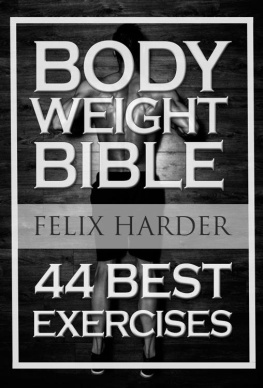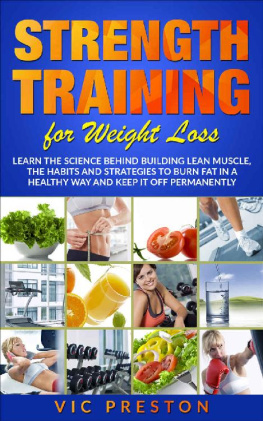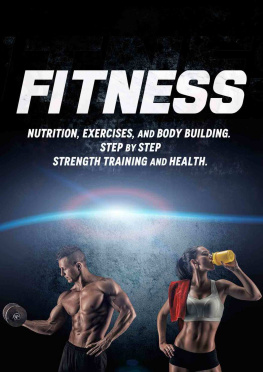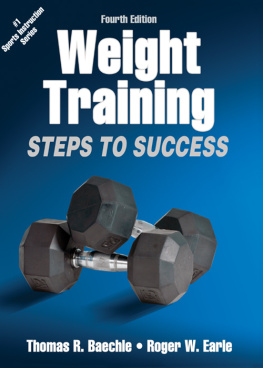The Progressive Calisthenics Program for Everyone
Steve Rader
Form Is Everything
Text and Exercise Pictures Copyright 2020 Stephen D. Rader All Rights Reserved
Disclaimer:
Stephen Rader is not liable for any injuries or damages that individuals might incur by attempting to perform any of the exercises or feats of strength depicted or discussed in this book. Any individual attempting to does so at their own risk. Consult with your physician before beginning an exercise regimen.
Acknowledgments
Id like to thank my wife, Patricia, for serving as my editor and, most of all, for supporting me on this journey to become a personal trainer at such an advanced age. Id like to thank my daughter, Sophia, for serving as chief photographer and graphic designer and for creating all the exercise images in this book. Id also like to thank my son, George, for inspiring me with his own personal calisthenics journey and for compelling me to try and keep up with him.
TABLE OF CONTENTS
Introduction
Welcome to calisthenics, the most versatile, approachable, and effective form of strength training you can do! You are in good company; calisthenics has helped people get fit and strong for thousands of years. Calisthenics was invented by the Greeks several thousand years ago. They named it, developed it, and perfected it, as they did with most things worth knowing, doing, and having. Kalli (good, beautiful) sthenos (strength). They definitely used it to their advantage in times of battle. This book is about strength training using body-weight calisthenics . This means that we are not using any external weight to provide resistance as is done in weightlifting. Rather, we are using our own body weight as resistance and are relying on variations in body position and limb placement to make exercises more or less difficult.
This book is designed to help you get started or move to the next level in calisthenics and to develop or improve a progressive program of your own that can offer a lifetimes worth of strength training and personal development. The comprehensive three-phase program included here can be done by anyone, from the absolute beginner to the more experienced athlete. We will be doing body-weight calisthenics, which means that we will not be adding any external weight for resistance. Instead, increased resistance is accomplished by changing the body position or angle, and these leverage changes will make the exercises more or less difficult.
For this calisthenics program, we will utilize three different exercise groupings, the Push Group, the Pull Group, and the Squat Group. This will give us a firm foundation upon which to build our strength and abilities. We will begin by mastering the basic movement patterns until we are comfortable performing them multiple times with good form. We will then build a basic workout program and learn to progress in volume and intensity. Strength gains will follow rapidly. Once we have progressed in volume and intensity, we have set the scene to move to more advanced exercises and re-program our workouts for the next phase .
Who Is the Target Audience?
The target audience for this book is people who are new to strength training, or are interested in trying calisthenics for the first time regardless of their strength-training background, or have been doing calisthenics for a while but need a strategy to move to the next level. Recovering weightlifters? You are welcome here. Exhausted chronic cardio junkies, come on inside! If you are out of shape and stressed about it, but even more stressed about how to get started and what to do, this book is for you. If you have been doing push-ups for a while now but need to know where to go next, this book is for you. Calisthenics in general and this program specifically will appeal to people who are not necessarily interested in gyms, equipment, and a lot of time and hassle around exercising. The exercises described here can be performed just about anywhere with minimal to no requirements in terms of equipment, money, time, and special clothing.
What Is Needed to Get Started?
Aside from willingness and an open mind, the only thing needed in terms of equipment to get started is something to use for the pulling movements that will be described later. This can be a bar or set of gymnastics rings or suspension grips that can be moved to about waist height or higher and can safely support at least half your body weight. As will be explained in more detail later, you can use just about anything, including a table-top, two dog leashes connected to one another and hung over a limb, a tree limb, or two chairs placed back-to-back with a sturdy stick across the top.
What is Covered in This Book?
This book will describe the three essential movement groups that are required for balanced, full-body strength and conditioning: the Pull Group, the Push Group, and the Squat Group. The book will teach you several different exercises within each of these three groups, how to perform them correctly, and how to change them slightly in order to make them more difficult. You will learn how to set your starting point by picking the exercises that are appropriate for your level in the three groupings, and you will learn how to: master the basic movements (Phase 1), program your workouts to make continuous progress (Phase 2), and finally, move on to more difficult exercises and reduce your reps and then build them up again (Phase 3).
What Will You Gain from This Book?
Most importantly, you will gain strength, fitness, flexibility, a tighter core, and a new sense of autonomy and independence about strength training. You will gain the skills and knowledge for a lifetime of approachable and enjoyable growth and improvement! You will gain an enthusiasm for simplicity in exercise and the excitement that comes with learning that you need nothing much more than a floor or a tree branch, a few minutes a day, and a creative mind to get a good workout. And I would like nothing more than if you got from this book a confidence and understanding of how you might achieve a strength goal that you never before thought possible. Ive met many people both younger than me and older than me who have said I have never been able to do a pull-up. Well, lets get that first pull-up!
My Perspective and Purpose
I am a certified Progressive Calisthenics Instructor and I see two main facets to my job: to educate and continuously motivate clients and students to learn that anyone can do strength training and make continuous progress, and to de-mystify and untangle the concept of fitness and health from the massive web of disinformation and profit-driven dogma that pervade the fitness industry. I am your very own coach, cheerleader, and BS-buster! This book represents an entry-point to this world.
Definitions
Sets and Reps
For any strength training exercise, calisthenics or otherwise, if you perform the movement once, you have done a single repetition, or rep. Performing several reps in a row is a set. If you do 10 push-ups and then rest and then do 10 more, you have done two sets of 10 reps. Drop and give me twenty means you have done one set of 20 reps.
Workouts, Micro-Workouts, and Splits
It used to be the case that a workout was always a single block of time during the day dedicated to exercise. During that block of time you may work all the muscles of your body or you may split your work into related exercises for only a part of the body. If you do all your pushing sets, all your pulling sets, and all your squatting sets in a single 40-minute period of time, for example, you have done a full-body workout . If you are more advanced or have less time, you may split your workouts into pushing and pulling movements one day and squats on the next. This is an upper-body / lower-body split routine. Similarly, if you do all the push exercises on one day, all the pull exercises the next day, and all leg exercises the third, you have done a push/pull/legs split .









